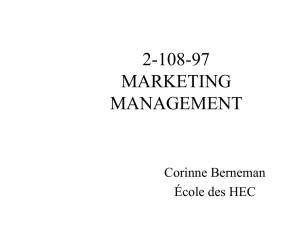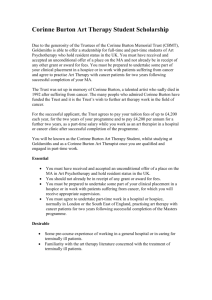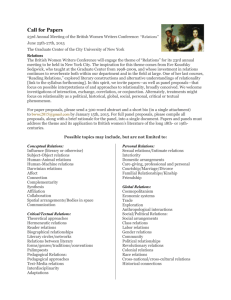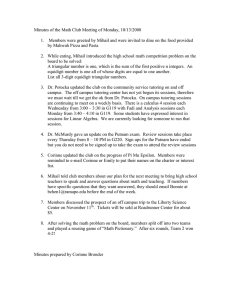Transcript of Example Wrap-up Discussion #2 hour, Day 4)
advertisement
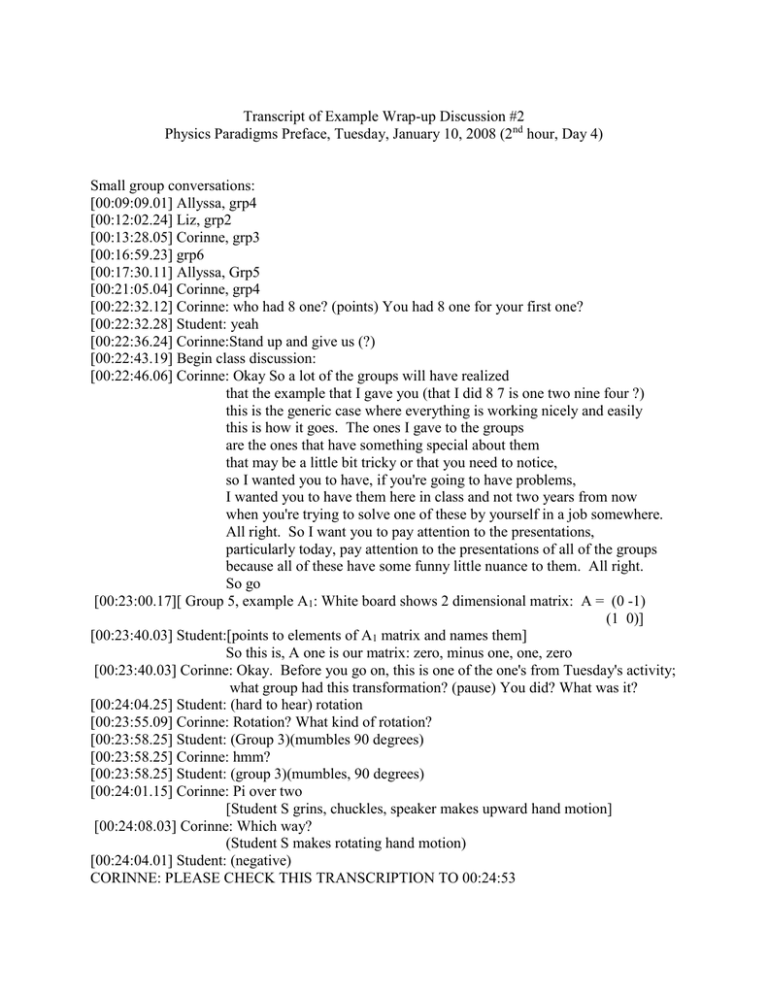
Transcript of Example Wrap-up Discussion #2 Physics Paradigms Preface, Tuesday, January 10, 2008 (2nd hour, Day 4) Small group conversations: [00:09:09.01] Allyssa, grp4 [00:12:02.24] Liz, grp2 [00:13:28.05] Corinne, grp3 [00:16:59.23] grp6 [00:17:30.11] Allyssa, Grp5 [00:21:05.04] Corinne, grp4 [00:22:32.12] Corinne: who had 8 one? (points) You had 8 one for your first one? [00:22:32.28] Student: yeah [00:22:36.24] Corinne:Stand up and give us (?) [00:22:43.19] Begin class discussion: [00:22:46.06] Corinne: Okay So a lot of the groups will have realized that the example that I gave you (that I did 8 7 is one two nine four ?) this is the generic case where everything is working nicely and easily this is how it goes. The ones I gave to the groups are the ones that have something special about them that may be a little bit tricky or that you need to notice, so I wanted you to have, if you're going to have problems, I wanted you to have them here in class and not two years from now when you're trying to solve one of these by yourself in a job somewhere. All right. So I want you to pay attention to the presentations, particularly today, pay attention to the presentations of all of the groups because all of these have some funny little nuance to them. All right. So go [00:23:00.17][ Group 5, example A1: White board shows 2 dimensional matrix: A = (0 -1) (1 0)] [00:23:40.03] Student:[points to elements of A1 matrix and names them] So this is, A one is our matrix: zero, minus one, one, zero [00:23:40.03] Corinne: Okay. Before you go on, this is one of the one's from Tuesday's activity; what group had this transformation? (pause) You did? What was it? [00:24:04.25] Student: (hard to hear) rotation [00:23:55.09] Corinne: Rotation? What kind of rotation? [00:23:58.25] Student: (Group 3)(mumbles 90 degrees) [00:23:58.25] Corinne: hmm? [00:23:58.25] Student: (group 3)(mumbles, 90 degrees) [00:24:01.15] Corinne: Pi over two [Student S grins, chuckles, speaker makes upward hand motion] [00:24:08.03] Corinne: Which way? (Student S makes rotating hand motion) [00:24:04.01] Student: (negative) CORINNE: PLEASE CHECK THIS TRANSCRIPTION TO 00:24:53 [00:24:09.27] Corinne: If that’s a cosine sine, cosine minus sine , sine cosine , my guess is theta is plus pi over two. [points] [00:24:19.19][Student S is also pointing]: We didn't have that one, we had negative one. [00:24:22.00] Corinne: You had the other one; you had the inverse <yes> absolutely. okay. So this is rotation by pi over two. What's (the sign of) rotations by pi over two? clockwise. ooh. counterclockwise. [makes rotation gesture with right hand] [00:24:35.19] Corinne: Okay.And what vectors were unchanged by that transformation? Student R: none Corinne: None. Because this is a rotation. So we're looking for the vectors that were unchanged. right? And there were none. [00:24:50.09]Corinne: You're all aware now of what the situation is? [00:24:55.19] Corinne: Okay. [addresses student at the board] Go, (?) [00:25:00.06] Student: [stands back up] Ah you take the determinant of lamda times the identity minus A , you get Lambda squared plus one equals zero so lambda equals plus or minus i [00:25:12.25] Corinne:Ah Ha! So now we have complex numbers coming in, all right? Student at Table 6: (because the ?) [00:25:24.22]Corinne: This is called the characteristic equation. The equation for lambda is lamda squared plus one is equal to zero. And that has solutions lambda equals plus or minus i. The eigenvalue, this is the first example you have of eigenvalues that are complex. [00:25:41.17] Student: [front right says something, gestures with arm outstretched making a circular motion](what is its relation to yesterday’s discussion?) [00:25:43.03] Corinne: Let him finish [00:25:44.00] [student at board points to equation expressed with kets:] Student: So then you have A ket v equals lambda ket v. [ A|v> = |v> ] [student then points to equation]] (0 -1)(x) = i (x) (1 0)(y) (y)] Student: So we take A and multiply it by x, y and we set that equivalent to i multiplied by x,y [00:25:56.27} Student: Ah and as you can see by this beautiful work with the equations [student points to equations -y= ix; x=iy; x=1; y=-i] v is a vector that is 1, minus i or a ket that is one, minus i (1) (-i) [00:26:08.17] Student: All right. Following a similar operation with minus i we get one and i [points to (1) (i) and then points to eigenvectors [vertical: (1, -i), (1, i)] [00:26:17.13] Student: These are our eigenvectors and then we normalized them by taking the square root of the magnitudes so they become one over root two and minus i over root two and one over root two and i over root two. [00:26:32.16] Corinne: So the first eigenvector that you got, before you normalized it was one minus i [00:26:40.16] Corinne: Can you draw that on the board for me? [Student draws axes and labels them x (horizontal) and i (vertical]. [00:27:06.00][Student at board draws arrow downward and to left (third quadrant) turns and looks at Corinne; student at first table nearest the student at the board makes gesture with his hand to change the direction of the arrow (group 6?), can't hear what he says.] [00:27:17.16][Student at board erases arrow downward and to left in third quadrant, marks a unit on the vertical axis and draws arrow upward and to left in second quadrant.] Student: Oh yeah. [student comments that are hard to hear. Minus i] [00:27:29.23] [Student at board rubs out arrow and draws it downward to the right (fourth quadrant), turns and looks at Corinne) [00:27:38.05] Corinne: Do you all agree with that? [00:27:53.21] Student J: You need four dimensions for more than one component vector. [00:27:57.21] Corinne: You need four dimensions. [Student J] says that you need four dimensions and you've only got two. [00:28:04.17] Student: [student at board says something that’s hard to hear; others laugh] [00:28:04.17] Corinne: Okay. So why do you need four dimensions? (overlapping talk) [00:28:08.13] Student: [student at front table explains with gestures] (he labeled the axes i and x, so I mean it would be like i x to i <C: Okay> two dimension in x and y LISTEN TO CAM 6 [00:28:18.00] Corinne:. Absolutely! This a two dimensional piece of a four dimensional space. All right? So what are your axes? The one that you have this way (gestures horizontally with right arm) what did you plot on that? [00:28:27.12] Student: This one? [00:28:27.12] Corinne: Which piece of information? [00:28:30.26] Student: Ah, [ writes vertical vector (1,i)] Actually this would be like the real part [00:28:38.01] Corinne: The real part of what? [ student moves hand with chalk back and forth over the 1 of the vertical vector] [00:28:47.26] Corinne: It's the real part of the first entry. Right? What did you put on your second axis? [00:28:55.16] Student: The imaginary part. [00:28:55.16] Corinne: of? [00:28:58.09] Student: the second entry [00:28:58.09] Corinne: Of the second entry. So you, because the other two entries were zero, and you 'lucked out' [00:29:27.08] [students chuckle] [00:29:07.06] Corinne: Okay. The axes that you drew were the real part of the first entry and the imaginary part of the second entry. It looks like the real part of some complex number and the imaginary part of the same complex number [waves arms to demonstrate axes] but that's not what you did. It's not the real and imaginary parts of one entry. It's the real part of one entry and the imaginary part of the other one Student: (?) [00:29:31.19] Corinne: Okay. So. The group that did this back on Tuesday, you said there were no vectors that were unchanged. [00:29:43.15] [Student R says something can't hear about imaginary] [00:29:43.15] Corinne: but you weren't thinking about imaginary vectors. Right? You were working with just arrows that you could draw with a real part on the first part and a real part on the second part and that's the only entries they had. Okay? [00:29:59.06] Student: (that’s a rotation) [00:29:59.06] Corinne: That's a rotation. The eigen If you do a rotation in two dimensions, every vector rotates [reaches for small white board and rotates it] if you're thinking about just the real ones but there are eigenvectors to such a matrix, they're just complex. So in the four dimensional space, there are some things that don't get rotated. [00:30:23.28] Corinne: Okay. Group number 2. Team 2 [Student at front table (Table 1) gets up, takes two white boards to front, places one on blackboard ledge, points to matrix at top left of white board] [00:30:46.27] Student: Ah so we had this one right here, zero one one zero [00:30:46.19] Corinne: Okay, I'll interrupt everybody. Who had this one on Tuesday? [low level student talk with one another, laughter] Nobody's going to admit to it? Okay. So everybody then, what, what does this matrix do to real vectors? [00:31:07.17] Student: It reflects [00:31:07.17] Corinne: It reflects (short pause) along (drawn out) what line? [00:31:14.09] Students: y = x, y axis [00:31:14.09] Corinne: It reflects along y = x. So what do we expect to be eigenvectors? [00:31:21.14] Student: y=x; one one [00:31:21.14] Corinne: One one. Okay. Go ahead. [00:31:25.25] Student: Ah, so [gestures with arm][laughter] [00:31:33.08] Corinne: Before you set off doing a calculation, ask yourself if you know the answer. S? Corinne: Ok, because it really helps you to keep from making algebra mistakes if you know what you're supposed to be getting. Go ahead Student: I thought that was the whole point of physics. You're supposed to think you get something and you get something totally different and you make sense of it. [00:31:50:00] [laughter] [00:31:53.11] Student: And then you get the Nobel Prize. [00:31:56:27] Corinne: Lots of time in classroom physics you don't get a Nobel Prize. [00:32:00:00] [laughter [00:32:01.14] Student: So, ah,run through the math and again our lambda values are one and negative one, so our vectors are one, one and one, negative one [points to vertical vectors |v1> = [1,1] |v2>= [1, -1] [00:32:16.20] Corinne: Okay. So you have one that is along x y, along the line x = y, but what's that other one? [00:32:20.15] Student: Ah that is the one that is 90 degrees perpendicular to [00:32:31.28] Corinne:(softly) pi over two [00:32:33.24] Student:pi over two, same thing (laughs) [00:32:35.05] Student: Ah, it's pi over two shifted so cause eigenvalues can [gestures, looking uncertain] change, well, it's just a rev - it's a negative of itself [moves arm back and forth horizontally] it's ninety, ah , pi shifted from itself, which makes it just the opposite [00:32:51.11] Corinne: (just the opposite) so can you draw those? [00:32:53.24] Student: [student draws axes] y=x line here's one, one [draws arrow from original along y=x in first quadrant], [draws arrow from origin to fourth quadrant,1, -1] one negative one [00:33:15.12] Corinne: So one, one goes to itself and one, negative one goes to minus itself [student looks around at Corinne, nods head] good. So this is why we want to include multiplication by negative one as still being, pointing in the same direction in quotes [makes signs for quotation marks with both arms raised] our generalized sense of direction because of this solution to the eigenvalue equation. [00:33:37.19] Corinne: Great. Thank you. Group Number Three. [00:33:43.14] Student [carries white board From Table 3 to front and places on blackboard ledge] You're not going to be able to read this because I didn't draw the lines (?). So the thing in purple is A 3. Our matrix is negative one zero zero negative one [points to matrix on whiteboard] you (? over the diagonal) take the determinant, [points] our lambda value is one. (we only have one) [holds up one finger] (one lamda value) [00:34:03.00] Corinne: How can that be if it was a quadratic equation? [00:34:09.13] Student: [moves hand over (lambda-1)(lambda-1) = 0] it was the same thing [00:34:19.05] Corinne: You got a repeated root [00:34:19.05] Student: Yes [00:34:19.05] Corinne: It was lambda minus one times lambda minus one [student nods yes] Okay. You got lambda equals one twice. [00:34:25.24] Student: Yes [00:34:25.24] Corinne: (excellent) Go ahead. [00:34:27.17] Student: Umm, [moves hand over calculations] so you do the thing you're supposed to do to find vectors, A times x y and lamda times x y and you solve and we got y equals negative two x so it made x one,[points to x=1] y is equal to negative two. (?) [00:34:44.07] Corinne: Okay. I don't believe your algebra. Go where you said lambda equals one, where you have a circle <yes> go up a line, up one from there, you have lambda minus one times lamba minus one, [(-1)(-1)] go up two lines from that, you have minus one minus lambda times minus one minus lambda, [(-1-)(-1-)] I don't think those are the same equations.<okay> how did you get from one to the other? [00:35:15.13] Student: [points with finger][other students start to offer comments] [00:35:25.11] Corinne: [walks to board] Students do this a lot. I'm seen, so here you have a nicely factored quadratic and you multiplied it out [points to quadratic equation on whiteboard] [00:35:36.22] Student:(realized didn't have to?) [00:35:36.22] Corinne: And then you realized you didn't have to but you should have gone back to here [points] it's just a simple sign error, right? If you take out a minus one out of here it s lambda plus one, not lamda minus one. <?> These have the same sign, those have opposite signs. (?) But what students do a lot is, they'll have a nicely factored thing, they'll write it out like this, and then they'll use the quadratic formula to factor it again (and undo this multiplying?) it looks like you've realized it but there's still this multiplier, but the eigenvalues actually are lambda equal minus one <okay> okay? [00:36:04.18] Corinne: But here's this matrix, minus one times the identity, minus one times the identity. What does that operation do? [00:36:13.21] Student:(?) [00:36:13.21] Corinne: It's negative one times the identity, so what does it do to a vector? [00:36:23.05] [Student:multiple student answers [00:36:31.18] Corinne: It's a pi rotation, or which just ends up taking everything to minus itself, so if takes everything to minus itself, what are the eigenvectors? Everything! Okay? So you got x equals one and y equals minus two for example but actually EVERYTHING is an eigenvector. Let's see group number three. Oh no. Four is eight E. Give me five <we did six> Give me six. (you had the original six. Let’s not do the original six ) Let's do this one next. [00:37:15.21] Student: [Student (from Table 4) carries white board to front and places on blackboard ledge] [00:37:47.01] Student: Our matrix was negative one zero zero zero negative one, this thing here [points to three by three matrix with zeros everywhere but on the diagonal] (?) [00:37:33.08] Corinne: Ah [Student T] Lots of times people, if they have a matrix that has things only on the diagonal, instead of saying minus one zero zero zero minus one, you got tired right? and quit in the middle? <yeah><laughter> which is what everybody does, if it's just diagonal? the convention is to say it's diagonal and you just read off the diagonal ones and then everybody knows its diagonal. [00:37:58.11] Student: It's diagonal, with one negative one one [00:38:03.16] Corinne: Okay. Now how does that compare to the one that [Student J] just did? [00:38:06.18] Student: It's the same matrix except it's three by three with a one [points to one in the bottom right corner of the three by three matrix] [00:38:09.25] Corinne: So that upper left corner is the same as what [Student J] just did. That's why I wanted to do this one next. [00:38:14.16] Corinne: Okay. Now. So what do you all expect here? Do you have any expectations? [00:38:15.02] Student: [At Table 1)(?)as we saw earlier (?) [00:38:29.13] Student: I expect it to be [00:38:31.26] Corinne: What are you saying, say that again, what do you expect to happen along the z axis? [00:38:37.26] Student: [Table 1] nothing [00:38:37.26] Corinne: Nothing, you expect the z axis to be unchanged and therefore you expect it to be an eigenvector [waves hands] yes! [00:38:49.16] Student T: [at the board] If I didn't do this beforehand and then I saw hers [points to Student J’s whiteboard] and then I started to do this, I'd expect one of my eigenvalues to be their eigenvalue, that's what I'd expect [00:39:02.02] Corinne: Okay so you're expecting the same eigenvalues as [Student J’s] so [StudentJ]’s group should have gotten one, minus one, Okay. So [00:39:10.05] Student: Running through the calculation [points to calculations on his whiteboard] we got eigenvalues of negative one, which repeats itself, and one and our eigen [00:39:22.19] Corinne: So you got lambda equals minus one, lambda equals minus one, just like [Student J]'s group, and one <yes> okay. [00:39:26.21] Student: Ah doing lambda equals one first, our equation is [points to board] negative x equals x, negative y equals y, and z equals z and our eigenvector for it to solve for all three of these equations is any scalar times zero zero one [points to board, |v> = alpha (vertical vector 0,0,1)]] [00:39:42.19] Corinne: This is one of the tricky things I wanted you all to see. If you get the equation minus x equals x as one of your equations when you're solving for the eigenvector, what are the solutions of minus x equals x? [00:40:01.19] Several Students: Zero [00:40:38.23] Corinne: Zero, Okay? Zero is a number, it's a possible answer and you may well get zero (Student S smiles) One of the components has to be zero. So if you see -x = x don't freak and say there are no solutions, there is a solution, x = zero. All right. So for your lambda equqls one you got 0, 0, 1, (which is, Student R?) Student R; (?) [00:40:34.21] Student: k hat [00:40:34.21] Corinne: k hat absolutely and you got any scalar multiple of k hat, so any vector that lies along the z axis, is an eigenvector with eigenvalue [00:40:45.01] Student: one [00:40:45.01] Corinne: one. It's not stretched, it's not rotated, it doesn't change at all. Okay. Any other ones? [00:40:51.21] Student T: For lamda equals negative one, we got negative x equals negative x, negative y equals negative y and z equals negative z so our eigenvector is 1, 1, 0 times a scalar [00:41:10.00] Corinne: Okay. So if you've got negative x equals negative x, x can be (pause) Student T: Anything Corinne: Anything and you also got y to be Student T: Anything [00:41:19.28] Corinne: So you picked one, one, zero, you picked the same anything for x as you did for y Student T: So you're saying y could be something different from x [00:41:31.01] Corinne: y could be something different from x and you do have to be careful in this sense that if you get several different things that can be anything, they can be different [moves arms in a circle] anythings, don't necessarily pick them to be the same. Now I will actually myself [gets up and goes to blackblard] to remind myself of this, I will write them as, I will write it as anything, anything zero [writes vertical vector anything, anything, zero] [00:41:58.01] Corinne: Okay, but how many eigenvectors are there with the eigenvalue minus one? [pauses]<infinite> There are an infinite number of eigenvectors. There are even an infinite number of normalized eigenvectors. [turns to [Student J]'s white board] So here we have two cases, where we have minus one, minus one on the diagonal [points to [Student T]'s white board] and minus one minus one on the diagonal and we got MORE eigenvectors than we were expecting, there wasn't just one [moves finger up and down], for each up to (?) [00:42:28.15] Student M: alpha,1, 0,0 plus beta zero, one, zero [00:42:31.27] Corinne: Yes so you can write it as, the eigenvectors as, that's a really nice way to write it, [writes on board while saying] alpha one zero plus beta zero one for any values of alpha and beta, [alpha vertical vector (1, 0) plus beta vertical vector (0, 1)] all of them can be written this way [points to board]. This is actually a two - well what is this? [changes 2 dimensional vectorss to three dimensional vectors by adding zeros so (1,0,0) and (0,1,0)] [00:42:46.03] Corinne: So this is x hat or i hat [points to alpha (1,0,0)] and j hat [points to beta (0,1,0), so any vector that lies in the x y plane, that whole plane [moves arms to form horizontal plane] full of them, is an eigenvector with eigenvalue minus one. This is a situation that's called degeneracy [writes 'degenercy' on board] and it happens any time you have a repeated eigenvalue, so [turns to point to [Student J]’s white board] [00:43:17.28] Student: (does this have a degeneracy of two?) [00:43:17.28] Corinne: This has a degeneracy of, yeah, it’s a two dimensional, the degeneracy gives you a two dimensional, it's called an eigen space [moves arms] and we'll talk more about this tomorrow. All right. [00:43:27.13] Corinne: Group number, who had a's and d's. You had a's and d's? [00:43:35.23] Student:(?) [00:43:35.23] Corinne: (?) the first one? <yeah> Give us a thirty second presentation. [walks back to rear of room and sits down] [00:43:46.16] Student: [student from Table 2 carries white board to front and places it on black board ledge. The word DEGENERATE!!! is written across matrices] So we had a diagonal matrix with a and d (a, 0, 0 d) [points at matrix] [00:43:54.22] Student: So we went through and we used the general equation to solve for the eigenvalues which were a and d cause [waves hands at equations] you know all these reasons, anyways [00:44:01.08] Corinne: Wait! Are those reasons obvious? [00:44:01.08] Student: Well, solving the quadratic [points to equation (lambda-a)(lambda -d)=0] Liz pointed out you don't really need to solve it when you know that a minus a is zero and d minus d is zero [00:44:10.23] Corinne: Okay. So suppose you had a 27 by 27 matrix and it was diagonal [student mocks being shocked and waves body and arms, Corinne repeats her challenge] Suppose you had a 27 by 27 matrix and it was diagonal, what would its eignvalues be? [00:44:25.04] Student: (diagonal) [00:44:27.11] Corinne: All the elements on the diagonal [00:44:32.22] Student: [at the board, waves his hands](?) [00:44:32.22] Corinne: Yeah! Okay. So not that long, 27 (?) [00:44:36.17][Student S grinning] [00:44:39.13] Student: Anyways, a long story short, we went through and we used this equation right here[points to white board] After we were done, we plugged it back in with our eigenvalues each one and the first one we did was a and we got this equation [points to ax + 0y = ax] so we used the bottom one and said that the only case that dy equals ay is y equals zero and therefore x can equal anything and then we just did the exact same thing on the other one so we got our vectors one zero and zero one. [00:45:06.08] Corinne: Okay <?> any time, any time you have a diagonal matrix, the eigenvalues are just the elements of the diagonal and the eigenvectors are one zero and zero one. They're i hat and j hat, and k hat, they're the really nice eigenvectors.[student returns to seat at Table 2] It's trival. You will come to know and love diagonal matrices. Okay? All right. [walks to front of room] There's a homework assignment up here and we'll see you tomorrow. Remember that there's a quiz and you will have to do this and it will not be such a tricky one. [00:46:26.05] End of class
